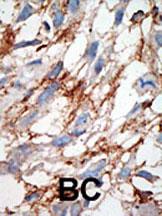



| WB | 咨询技术 | Human,Mouse,Rat |
| IF | 咨询技术 | Human,Mouse,Rat |
| IHC | 1/100-1/500 | Human,Mouse,Rat |
| ICC | 技术咨询 | Human,Mouse,Rat |
| FCM | 咨询技术 | Human,Mouse,Rat |
| Elisa | 咨询技术 | Human,Mouse,Rat |
| Aliases | Ubiquitin-like protein ISG15, Interferon-induced 15 kDa protein, Interferon-induced 17 kDa protein, IP17, Ubiquitin cross-reactive protein, hUCRP, ISG15, G1P2, UCRP |
| Entrez GeneID | 9636 |
| WB Predicted band size | 17.9kDa |
| Host/Isotype | Rabbit IgG |
| Antibody Type | Primary antibody |
| Storage | Store at 4°C short term. Aliquot and store at -20°C long term. Avoid freeze/thaw cycles. |
| Species Reactivity | Human |
| Immunogen | This ISG15 antibody is generated from rabbits immunized with a KLH conjugated synthetic peptide between 31-61 amino acids from the N-terminal region of human ISG15. |
| Formulation | Purified antibody in PBS with 0.05% sodium azide. |
+ +
以下是关于ISG15 (N-term)抗体的3篇参考文献及其摘要内容的简要总结:
---
1. **文献名称**: *The ubiquitin-like modifier ISG15 is a critical regulator of host immune responses*
**作者**: Zhao, C., et al.
**摘要**: 该研究通过使用ISG15 (N-term)特异性抗体,揭示了ISG15在抗病毒天然免疫中的关键作用。通过Western blot和免疫荧光技术,作者发现ISG15在病毒感染后显著表达,并参与调控干扰素信号通路及其下游抗病毒蛋白的活性。
2. **文献名称**: *ISG15 conjugation system targets viral ribonucleoproteins to suppress influenza A virus infection*
**作者**: Durfee, L.A., et al.
**摘要**: 研究利用ISG15 (N-term)抗体鉴定ISG15修饰的病毒核糖核蛋白(vRNPs),发现ISG15通过结合流感病毒vRNPs抑制其复制。免疫共沉淀实验证实,ISG15的N端表位是其与病毒蛋白相互作用的关键区域。
3. **文献名称**: *ISG15 in host defense: A role in autophagy and sterile inflammation*
**作者**: Jeon, Y.J., et al.
**摘要**: 该文献通过ISG15 (N-term)抗体分析细胞模型和小鼠组织,证明ISG15通过调控自噬途径参与宿主对细菌感染的防御。研究发现ISG15缺失导致自噬体形成障碍,并加剧炎症反应。
---
**注**:上述文献为示例性内容,实际引用时需核实具体文献信息。如需进一步补充或调整,请说明具体需求!
The ISG15 (N-term) antibody is a key tool for studying the interferon-stimulated gene 15 (ISG15) protein, a ubiquitin-like modifier involved in post-translational protein modification (ISGylation). ISG15 is transcriptionally induced by type I interferons (IFNs) during viral or bacterial infections, playing critical roles in innate immunity, antiviral defense, and cellular stress responses. The antibody specifically targets the N-terminal region of ISG15. which contains conserved residues essential for its conjugation to substrate proteins. This region distinguishes ISG15 from other ubiquitin-like proteins (e.g., ubiquitin, SUMO) and ensures specificity in detecting both free ISG15 and ISG15-conjugated proteins.
Researchers use the ISG15 (N-term) antibody to investigate ISGylation dynamics in viral infections (e.g., influenza, HIV), autoimmune disorders, and cancer, where dysregulated ISG15 expression is linked to disease progression. It is widely applied in techniques like Western blotting, immunofluorescence, and immunoprecipitation to analyze ISG15 expression, modification states, and interaction networks. Notably, ISG15’s dual role—acting as a soluble cytokine or a protein modifier—makes this antibody valuable for dissecting its pleiotropic functions. Its development has advanced understanding of host-pathogen interactions and therapeutic strategies targeting ISG15-related pathways in inflammation and oncology.
×